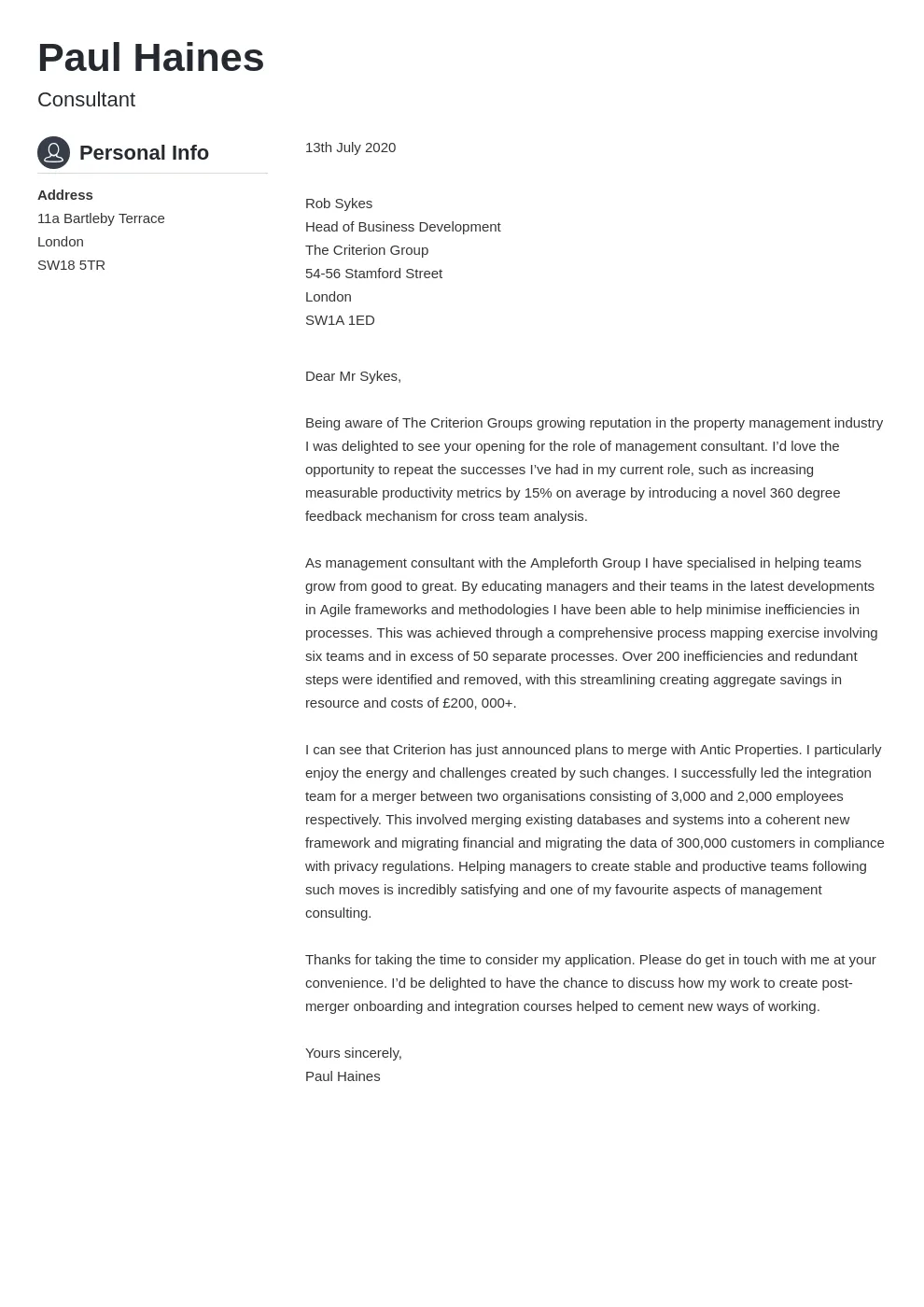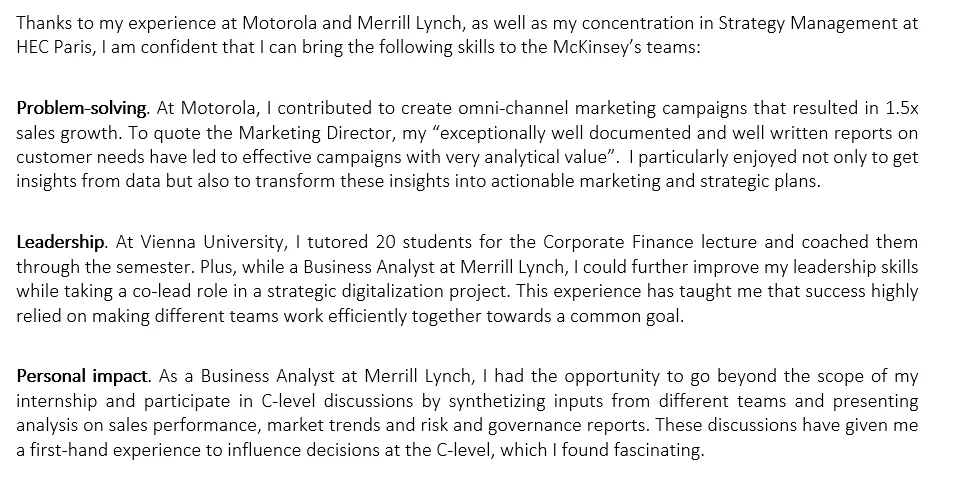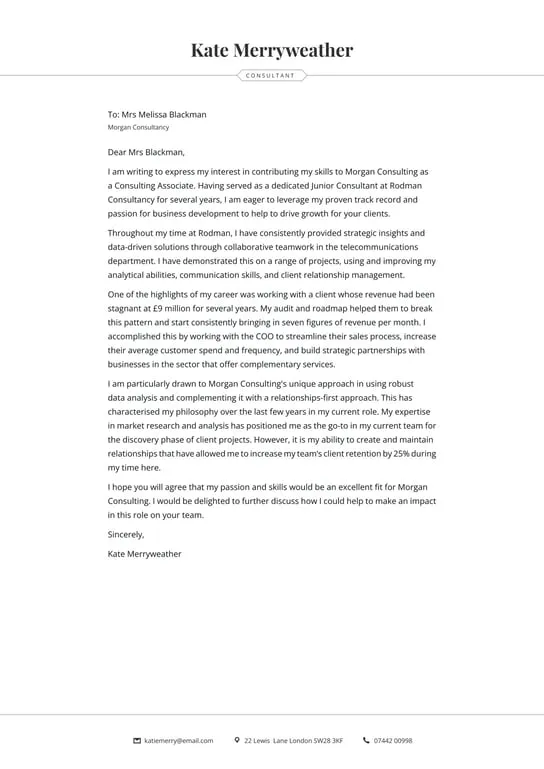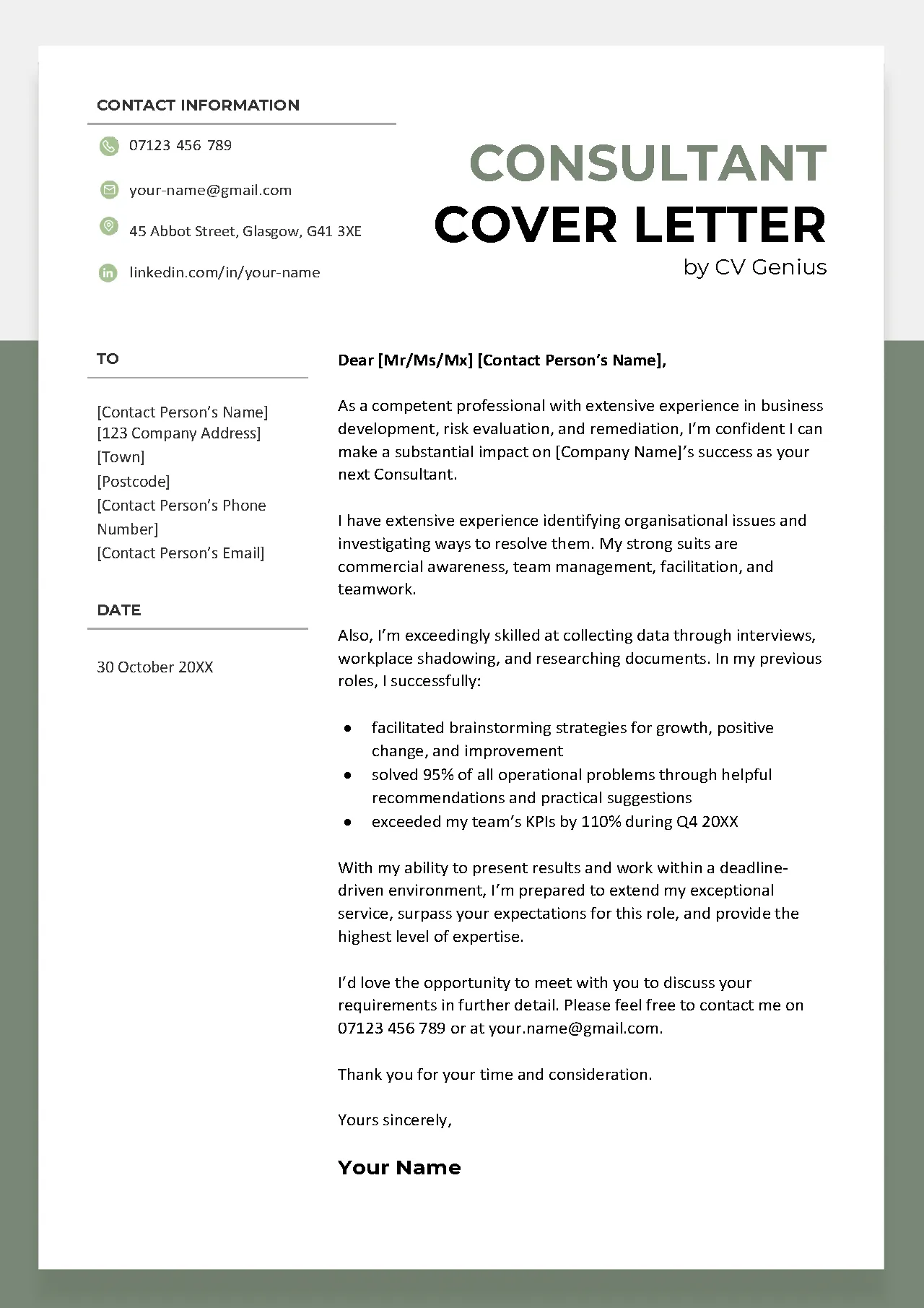Why a Consulting Cover Letter is Crucial
In the competitive world of consulting, a well-crafted cover letter is not just a formality it’s your first opportunity to make a lasting impression. It’s your chance to go beyond the bullet points of your resume and paint a compelling picture of who you are and what you can bring to the table. A strong cover letter acts as a personal introduction, showcasing your personality, passion for consulting, and the unique value you offer. It allows you to demonstrate your understanding of the firm’s needs and how your skills align with their goals. A lackluster cover letter can quickly lead to your application being overlooked, even if your resume is impressive. Therefore, investing time and effort into creating a persuasive cover letter is essential to landing your dream consulting role. It’s your key to unlocking the door to an interview and, ultimately, a successful career in consulting. A great cover letter can be the difference between getting an interview and your application being tossed in the trash.
Highlighting Your Skills and Experience
Your cover letter is the perfect platform to highlight the skills and experience that align with the specific consulting role you’re targeting. Begin by identifying the key skills and qualities the firm values, often outlined in the job description. Then, showcase how your background demonstrates these attributes. Consulting firms often look for candidates with strong problem-solving abilities, analytical thinking, communication proficiency, and leadership potential. Provide specific examples of situations where you successfully applied these skills. Did you lead a project team, solve a complex business issue, or present findings to senior management? Detail the outcomes of your actions to make your case more persuasive. Remember to provide specific instances rather than simply listing skills. For instance, instead of stating “Proficient in data analysis,” write “Utilized statistical modeling to identify inefficiencies, leading to a 15% cost reduction for a previous client.”
Quantify Your Achievements

One of the most effective ways to make your cover letter stand out is by quantifying your achievements. Numbers and data provide concrete evidence of your impact and the value you can bring to a consulting firm. Instead of vaguely stating you improved sales, specify the percentage increase you achieved. Rather than saying you managed a project, mention the budget size and any savings you generated. Start by reviewing your past experiences and identify the key accomplishments you’re proud of. Then, find quantifiable metrics that demonstrate your success. This could include increased revenue, cost savings, improved efficiency, or successful project completion. For instance, instead of writing “Improved customer satisfaction,” you could state “Increased customer satisfaction scores by 20%.” When possible, show the impact of your work using metrics, percentages, or dollar figures. Numbers are a universal language that consultants understand and appreciate. This adds credibility and shows potential employers the tangible results you can deliver. This will clearly show what you can offer.
Research the Consulting Firm
Demonstrating that you’ve done your homework on the consulting firm is essential. Tailor your cover letter to the specific company you’re applying to. Start by researching the firm’s values, mission, and recent projects. Take a look at their website, social media profiles, and any news articles or industry reports related to the company. Show you understand the firm’s focus and how your expertise aligns with their goals. Mention a specific project or initiative that interests you, and explain why it resonates with your values and career aspirations. If possible, address the letter to a specific person, such as the hiring manager or a partner, instead of using a generic greeting. This shows that you’ve put in extra effort and are genuinely interested in the opportunity. Doing your research shows that you’re not just sending a generic application, but that you’re genuinely interested in the company. This will make you stand out and increase your chances of getting an interview.
Tailor Your Cover Letter
A one-size-fits-all cover letter is a recipe for rejection. To maximize your chances of success, it’s important to tailor your cover letter to each specific job application. Start by carefully reading the job description. Identify the key requirements and preferred qualifications. Then, adjust your letter to reflect how your skills and experiences align with those specific needs. Focus on the responsibilities that are most relevant to the position and highlight any related achievements. Use the same keywords and phrases that appear in the job description. This demonstrates that you understand the requirements and speak the same language as the hiring manager. Avoid generic statements and use specific examples to illustrate your capabilities. Be sure to adapt the content and tone to fit the firm’s culture and the specific role you are applying for. The goal is to clearly show why you are the best candidate for the job and why you are a great fit for the firm.
Formatting Your Consulting Cover Letter

The formatting of your consulting cover letter plays a critical role in making a positive first impression. A well-formatted letter is easy to read, professional, and demonstrates attention to detail. Begin with a clean and professional font, such as Times New Roman, Arial, or Calibri, and use a font size of 10 or 12 points. Ensure your letter has clear margins and appropriate spacing between paragraphs. This improves readability and makes the content more inviting. Use concise, well-structured paragraphs to highlight key points. Avoid long blocks of text. Break up the text with bullet points or numbered lists to emphasize key accomplishments and skills. Proofread the letter carefully for any grammatical errors or typos. A polished cover letter is a reflection of your professionalism and attention to detail. Ensure the formatting is consistent throughout, and the layout is visually appealing. A well-formatted letter showcases your professionalism and attention to detail, which are essential qualities for a consultant.
Showcase Your Consulting Skills
In your cover letter, emphasize the consulting skills that are most relevant to the role you’re applying for. Consultants are expected to have a blend of hard and soft skills. Common examples include problem-solving, analytical thinking, communication, project management, and teamwork. Provide evidence of how you’ve used these skills in past situations. Instead of simply stating that you’re a good problem solver, describe a situation where you successfully identified and resolved a complex issue. For example, you could describe how you analyzed a client’s business processes, identified bottlenecks, and implemented solutions that improved efficiency. Use specific examples to demonstrate your ability to communicate complex information clearly and persuasively. Highlight your experience in project management, including planning, organizing, and managing projects from start to finish. By showcasing your consulting skills, you demonstrate your ability to contribute to a project. This shows that you are well-prepared to take on the challenges of a consulting role.
Emphasize Relevant Experience
Your cover letter should focus on the experiences that are most relevant to the consulting role. If you have prior consulting experience, highlight the projects and clients you worked with. Describe the types of problems you solved, the methodologies you used, and the results you achieved. Even if you lack direct consulting experience, you can still demonstrate your suitability for the role by highlighting transferable skills. Focus on experiences that showcase your problem-solving abilities, analytical skills, and communication skills. These could include project management, business analysis, or leadership roles. Provide specific examples of situations where you successfully applied these skills. This could include leading a project team, solving a complex business issue, or presenting findings to senior management. Use the STAR method (Situation, Task, Action, Result) to structure your responses. This helps the reader quickly understand your contributions and accomplishments. Demonstrating your experiences is essential for showing how your expertise can be used in the position.
Proofread and Edit

Before submitting your cover letter, take the time to proofread and edit it meticulously. Errors, typos, and grammatical mistakes can undermine your credibility and make you appear unprofessional. Read the letter carefully, looking for any errors in spelling, grammar, and punctuation. Check for any inconsistencies in formatting. Consider having a friend, family member, or career advisor review your letter for feedback. They may identify errors or areas for improvement that you might have missed. Ensure that your letter is well-written, concise, and easy to understand. Eliminate any unnecessary jargon or overly complex language. The tone of your letter should be professional and enthusiastic. Proofreading is a necessary step in ensuring your professionalism and attention to detail. Taking the time to review the document will greatly improve the overall quality of your application.
Finalizing Your Consulting Cover Letter
After refining and editing your cover letter, the final step is to prepare it for submission. Save your cover letter in a professional format, such as PDF, to ensure that the formatting remains consistent across different devices. Review the job posting again to confirm the application instructions. Make sure you have addressed any specific requirements or preferences mentioned by the employer. Customize your cover letter for each application, as this demonstrates your interest and commitment. Double-check the contact information and ensure you’ve addressed the letter to the correct person. Ensure your contact details, including your name, phone number, and email address, are clearly visible. Proofread one final time to catch any last-minute errors. By taking these final steps, you ensure your application is polished, professional, and ready to impress the hiring manager. A well-crafted cover letter will increase your chances of making a positive impression and securing an interview.
